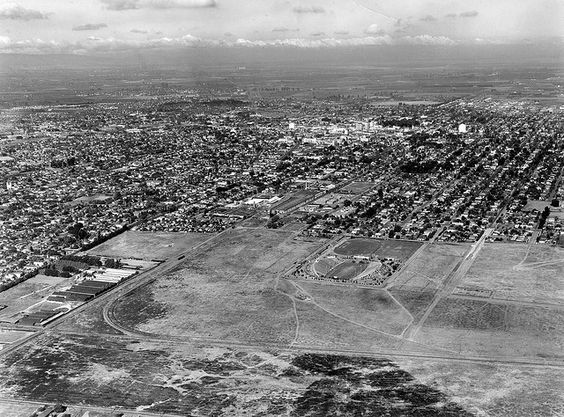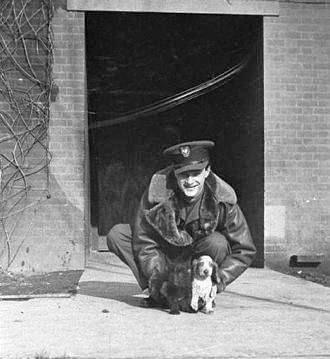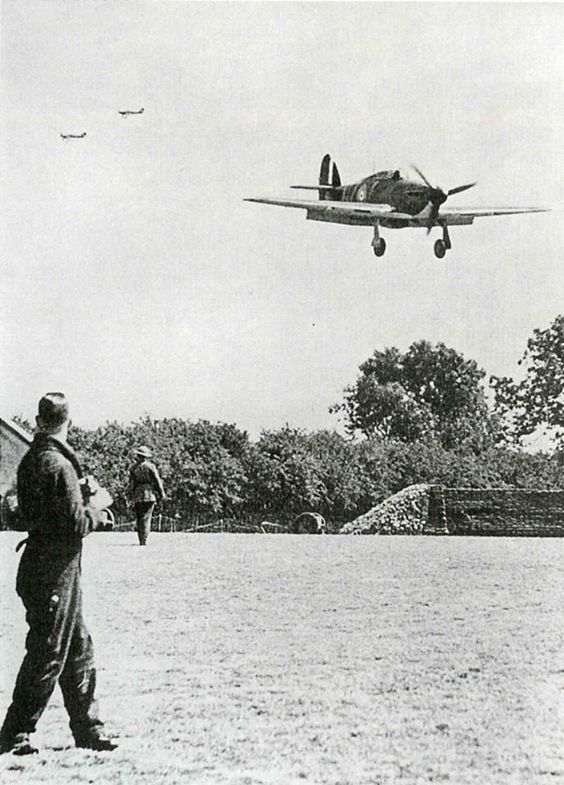Tuesday 8 October 1940
 |
| No. 71 Squadron RAF, "Eagle Squadron" is formed, comprising American volunteers. October 8, 1940. |
During the morning, there are Jabo attacks on London that begin around 08:30. Around that time, over 50 aircraft cross near Dungeness and hit London and the nearby airfields such as Biggin Hill, Hornchurch and Kenley. These Jabos can fly high, so Fighter Command has difficulty intercepting them. The flip side, of course, is that their bomb loads are small and thus can't cause much damage. The bombs cause the most damage around Tower Bridge, Whitehall (Paymaster General's Office, Ministry of Agriculture and Great Scotland Yard), Charing Cross Station, BBC House and houses in Bermondsey, Lewisham and West Ham.
Around 11:00, Dornier Do 17 bombers cross near Lympne. After an early RAF interception, the bombers drop their loads at random and scatter back to France.
After lunch, Junkers Ju 88 bombers cross over the Sussex coast at 13:00. They hit RAF West Hampnet and destroy a Boston bomber and damage a Blenheim. The raid is particularly effective and puts the airfield out of action. Other targets are Shoreham, West Malling and the Thorney Island airfield.
More small-scale raids continue throughout the afternoon. The most interesting incident is a special bombing mission against the Rooters aircraft factory at Speke by one specially equipped Junkers Ju 88 (M7+DK of KG 2,/806). It has four 250 kg bombs and has a Photographic War Correspondent (Bildberichter) on board. RAF No 312 (Czech) squadron based at Speke intercepts the plane, forcing it to make a crash landing at Bromborough Dock around 16:15. The plane is in good condition, is put on display, paraded through Liverpool, and then scrapped.
After dark, the Luftwaffe raids London, Portsmouth, Southampton, Liverpool, the Midlands, and East Anglia. It also conducts minelaying off the northeast coast. There is random damage to various factories and railway lines, but nothing major. There are large fires at the docks and warehouses of Bermondsey.
Losses for the day are about 14 for the Luftwaffe and 4 by the RAF.
The German coastal guns at Cap Gris Nez (Hellfire Corner) fire upon a couple of convoys during the afternoon, but accuracy at the distance is difficult and no hits are scored.
Sergeant Josef František, 27, the Czech fighter pilot flying with the Polish Squadron of the RAF (No. 303), perishes in a plane crash while landing at RAF Northolt in Cuddington Way at Ewell. He is the top scorer in the Battle of Britain with 17 kills. He receives numerous posthumous decorations.
Luftwaffe fighter pilots have small dinghies, worn on the pilot's back, and one accidentally inflates during a mission today. Lt. Heinz Escherhaus of 1./JG 77 is forced forward against the throttle, which blows out the engine and forcing him to force-land in Kent. It is the only recorded incident of a plane being brought down by a dinghy.
RAF No. 309 (Polish) Squadron begins forming at RAF Renfrew near Glasgow. The unit has used Westland Lysander Mk III two-seater reconnaissance planes.
Wing Commander John Harvey Hutchinson hits a barrage balloon cable at Langley, crashes and perishes.
European Air Operations: RAF Bomber Command is active during the night over the north German ports of Bremen and Wilhelmshaven. It makes other raids over various other places in northwest Europe, including the Channel ports. During the night, 17 bombers take off from Waddington, Lincolnshire to attack the Tirpitz under construction, with no effect.
 |
| A boy sits amid the ruins of a London bookshop following an air raid, reading a book titled "The History of London." October 8, 1940. |
U-58 (Oblt. zur See Heinrich Schonder), on her 11th patrol heading from Lorient to her new base at Bergen, spots the 4956-ton British freighter Cornfield, which is a straggler from Convoy HX 76, west of the Outer Hebrides (straggler due to issues with her cargo shifting). The U-boat torpedoes the Cornfield, causing the crew to abandon ship. There are 36 survivors, and one crewman perishes. The Cornfield stays afloat and eventually is spotted by Royal Navy sloop HMS Weston, which takes aboard the survivors (along with HMS Periwinkle). The Weston uses its deck gun to sink this hazard to navigation on the 9th.
The Luftwaffe bombs 839-ton British freighter Bellona II about 4 miles (7 km) off Gordoun, Kincardineshire. The crew abandons ship and there are 18 survivors, while 9 perish. The Bellona II is full of ice (300 tons) in order to bring fish back from Iceland, and three fish workers are among the dead. The ship is a total loss, but, perhaps buoyed by the ice, the derelict eventually drifts ashore at Streathlethan Bay, Aberdeenshire.
The Luftwaffe bombs and sinks 451 ton Royal Navy barrage balloon vessel HMS Borealis about 4 miles (7 km) south of the Isle of Wight. The Borealis is Dutch vessel leased after the fall of Holland.
German 222 ton trawler Hecht is sunk "by enemy action." I can't find much on this one.
British submarine HMS Trident spots U-31 transiting from its French base in France and fires torpedoes at it, but they miss. The two submarines then exchange gunfire, with the U-31 lightly damaged.
The Luftwaffe bombs and damages troopship 20,043-ton troopship Oronsay, which is traveling with Convoy WS 3. The liner makes it back to Lough Foyle.
Royal Navy gunboat HMS Locust hits a mine north of northwest Shingles Beacon and is seriously damaged. She makes it to Tilbury in tow.
Royal Navy minesweeper HMS Kellet is involved in a collision in the West Pier at Granton. The Kellet makes it back to Rosyth for repairs.
Convoy FN 303 departs from Southend, Convoy OA 226 departs from Methil, Convoy HX 79 departs from Halifax.
U-107 (Kapitänleutnant Günther Hessler) is commissioned.
 |
| King's College London quad after the 8 October 1940 bombing. The crater is 27 feet deep and 58 feet long. |
The RAF bombs Italian bases at Sollum and Bardia in Libya, and also at Aden and Assab.
At Malta, there is an air raid around Delimara at 19:35, but most of the bombers drop their ordnance at sea or at random. Two bombers are brought down.
Battle of the Pacific: German raiders Orion and Komet meet and begin operating together.
Anglo/Japanese Relations: The British re-open the Burma road (Lashio, Burma to Kunming, China). It has been closed pursuant to an agreement between the Japanese and the British since July. Chiang Kai-shek's Nationalist government needs supplies along that route, and the Japanese would greatly prefer that it remain closed.
Anglo/US Relations: Another tranche of destroyers is transferred from the US Navy to the Royal Navy pursuant to the destroyers for bases deal. These destroyers are in US Destroyer Divisions 68 and 71:
- USS Satterlee -> HMS Belmont
- USS Mason -> HMS Broadwater
- USS Hunt -> HMS Broadway
- USS Branch -> HMS Beverley
- USS Aulick -> HMS Burnham
- USS Laub -> HMS Burwell
- USS McLanahan -> HMS Bradford
- USS Edward -> HMS Buxton
German/Romanian Relations: German troops pour across the Romanian border - with the acquiescence of Ion Antonescu - to occupy various key points throughout the country. Their ostensible mission is to train Romanian troops - which don't really need much training. However, the Germans (Hitler) want them there to protect the oil fields (from the Soviets and British sabotage), while Antonescu wants them there to tighten ties with Germany and protect the country - which has been losing territory to all of its neighbors - from the Soviets. Many accounts state that the Germans now "occupy" Romania, but that is an immense exaggeration - they only secure specific points important to Hitler and, presumably, Antonescu.
US/Japanese Relations: The US State Department, reacting to the Tripartite Agreement between Japan, Germany, and Italy, issues an advisory for all US citizens in the Far East to return to the United States.
US Military: Naval Reserve Officers graduating from the Naval Reserve Officer Training Corps are now commissioned in the regular Navy.
British Military: Already a Knight Grand Cross of the Royal Victorian Order since 23 January 1937, Air Marshal Hugh Dowding becomes a Knight Grand Cross of the Order of the Bath.
Free France: General de Gaulle meets with General LeClerc in Cameroon. They discuss using the territory to conduct air attacks on the Italians in North Africa. There remains a strong Vichy French presence throughout the region.
French Indochina: Inspector General of Colonies Cazaux sends a telegram to General de Gaulle indicating his sympathies for Free France. However, at this point, General de Gaulle has no ability to take advantage of this, and French Indochina is dominated by the Japanese.
American Homefront: "The Long Voyage Home," starring John Wayne and directed by John Ford, premieres at the Rivoli Theatre in New York City.
The Cincinnati Reds win the World Series 4 games to 3 over the Detroit Tigers, winning 2-1. This is a very rare case of a team coming back from a 3-2 deficit in games to win.
October 1940
October 2, 1940: Hitler's Polish Plans
October 3, 1940: British Cabinet Shakeup
October 4, 1940: Brenner Pass Meeting
October 5, 1940: Mussolini Alters Strategy
October 6, 1940: Iron Guard Marches
October 7, 1940: McCollum Memo
October 8, 1940: Germans in Romania
October 9, 1940: John Lennon Arrives
October 10, 1940: Führer-Sofortprogramm
October 11, 1940: E-Boats Attack!
October 12, 1940: Sealion Cancelled
October 13, 1940: New World Order
October 14, 1940: Balham Tragedy
October 15, 1940: Mussolini Targets Greece
October 16, 1940: Japanese Seek Oil
October 17, 1940: RAF Shakeup
October 18, 1940: Convoy SC-7 Catastrophe
October 19, 1940: Convoy HX-79 Catastrophe
October 20, 1940: Convoy OB-229 Disaster
October 21, 1940: This Evil Man Hitler
October 22, 1940: Aktion Wagner-Burckel
October 23, 1940: Hitler at Hendaye
October 24, 1940: Hitler and Petain
October 25, 1940: Petain Woos Churchill
October 26, 1940: Empress of Britain Attack
October 27, 1940: Greece Rejects Italian Demands
October 28, 1940: Oxi Day
October 29, 1940: US Draft Begins
October 30, 1940: RAF Area Bombing Authorized
October 31, 1940: End of Battle of Britain
2020






